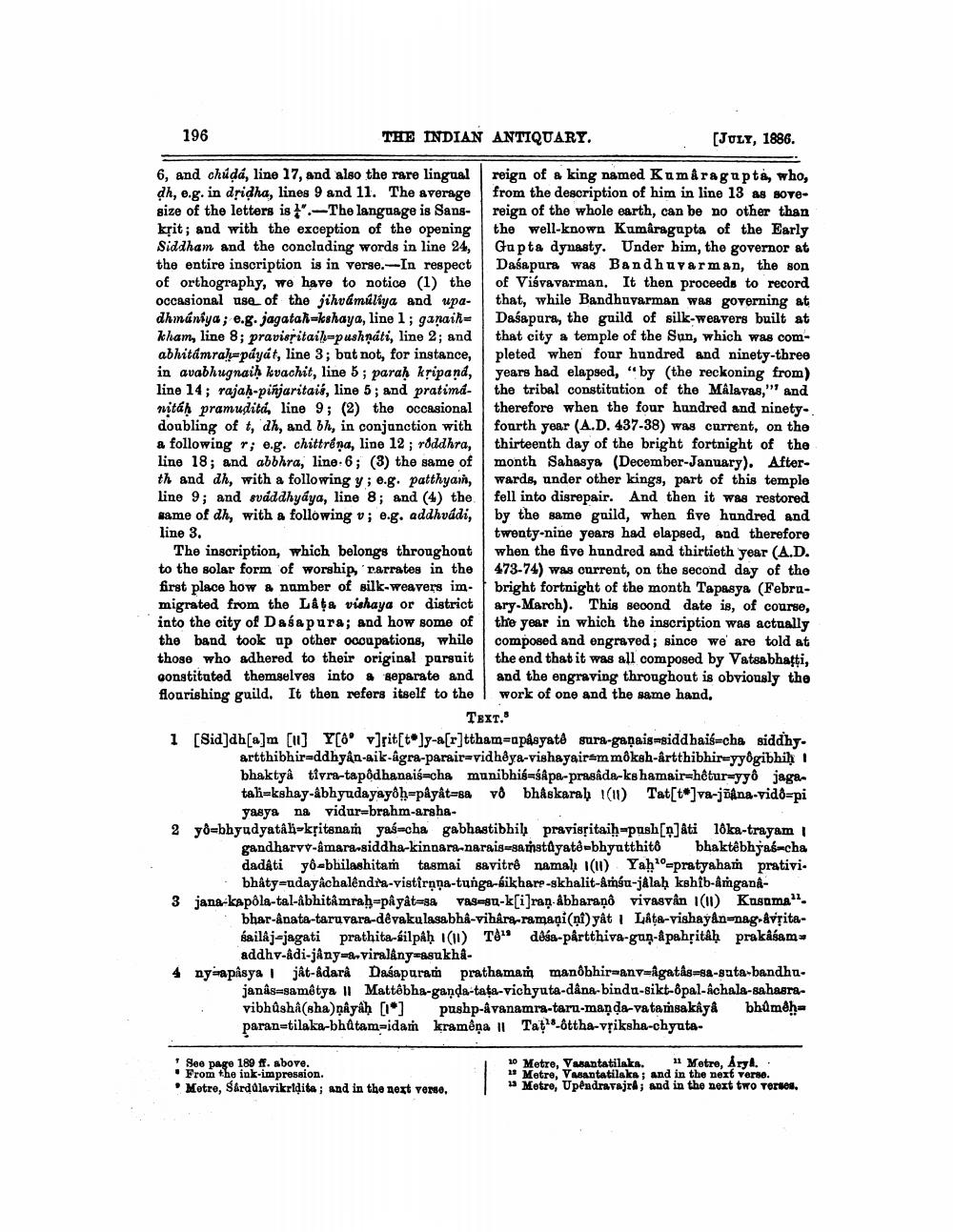________________
196
THE INDIAN ANTIQUARY.
(JULY, 1886.
6, and chudá, line 17, and also the rare lingual reign of a king named Kum&ragupta, who, dh, e.g. in dridha, lines 9 and 11. The average from the description of him in line 13 as sovesize of the letters is ". -The language is Sans- reign of the whole earth, can be no other than krit; and with the exception of the opening the well-known Kumâragupta of the Early Siddham and the concluding words in line 24, Gupta dynasty. Under him, the governor at the entire inscription is in verse. In respect Dasapura was Bandhu varman, the son of orthography, we have to notice (1) the of Visvavarman. It then proceeds to record occasional use of the jihvámúliya and upa- that, while Bandhuvarman was governing at dhmániya; e.g. jagatah=kshaya, line 1; ganaite Dasapura, the guild of silk-weavers built at kham, line 8; pravisritaik-pushnáti, line 2; and that city a temple of the Sun, which was comabhitámrah-páyát, line 3; but not, for instance, pleted when four hundred and ninety-three in avabhugnaih kvachit, line 5; parah kripand, years had elapsed, "by (the reckoning from) line 14; rajah-pinjaritais, line 5; and pratimd- the tribal constitution of the Mâlavas," and nitáh pramudita, line 9; (2) the occasional therefore when the four hundred and ninety-. doubling of t, dh, and bh, in conjunction with fourth year (A.D. 437-38) was current, on the a following r; e.g. chittréna, line 12; roddhra, thirteenth day of the bright fortnight of the line 18; and abbhra, line: 6; (3) the same of month Sahasya (December-January). Afterth and dh, with a following y; e.g. patthyan, wards, under other kings, part of this temple line 9; and sváddhyāya, line 8; and (4) the fell into disrepair. And then it was restored name of dh, with a following v; 0.g. addhvádi, by the same guild, when five hundred and line 3.
twenty-nine years had elapsed, and therefore The inscription, which belongs throughout when the five hundred and thirtieth year (A.D. to the solar form of worship, rarrates in the 473-74) was current, on the second day of the first place how a number of silk-weavers im. bright fortnight of the month Tapasya (Februmigrated from the Lâ¢& vishaya or district ary March). This second date is, of course, into the city of Daśa pura; and how some of the year in which the inscription was actually the band took up other occupations, while composed and engraved; since we are told at those who adhered to their original parsait the end that it was all composed by Vatsabhatti, constituted themselves into a separate and and the engraving throughout is obviously the flourishing guild. It then refers itself to the work of one and the same hand,
Text. 1 [Sid]dh[a]m [11] Y[6° v]rit[t]y-a[r]ttham=apásyaté sura-gaņais-siddhais=cha siddhy.
artthibhiraddhyân-aik-agra-parair-vid hêya-vishayairem môkah-artthibhireyyógibbih 1 bhaktyå tiyra-tapôdhanais-cha munibhis=s&pa-prasada-ks hamairahetur-yyô jagatab=kshay-abhyudayayðh-påyåt=s& vô bhåskarah (11) Tat[t]va-jõâna vido=pi
yasya na vidur=brahm-argha2 yo-bhyudyatâl-kpitanam yas-cha gabhastibhih pravissitaih-push[n]âti 10ka-trayam
gandharvv-âmara-siddha-kinnara-narais-samstdyatê-bhyatthit bhaktêbhyas-cha dadáti yê=bhilashitam tasmai savitre namal (11) Yaho-pratyaham prativi.
bhâty=udayachalêndia-vistirņņa-tunga-bikhare-skhalit-Amíu-jalaḥ kshib-angana3 jana-kapola-tal-Abhitamrah-pâyât=ga Vassu-k[i]ran ábharaṇô vivasvan (11) Kusoma".
bhar-ånata-taruvara-dévakulasabha-vihárs-ramasi(ni) yât i Låta-vishayannag-avritasailkj-jagati prathita-silpaḥ (11) Tê" désa-partthiva-gan-apahřitáh prakasama
addhv-adi-jâny=-viralány=asukha4 ny=apasya | jât-Adara Dasapuram prathamar manôbhir=anv=agat&s=sa-sata-bandhu.
janâs=samêtya | Mattêbha-ganda-tata-vichyuta-dana-bindu-sikt-pal-Achala-sahasravibhůshi (sha)nayah (1) pushp-dvanamra-taru-manda-vataṁsakay& bhūméhparan=tilaka-bhatam-idam kramêņa | Tati-ottha-vriksha-chyute
See page 189 ff. above. From the ink-impression. Metre, Sardúlavikridita; and in the next verse,
10 Metre, Vasantatilaka. Metre, Arya. 19 Metre, Vasantatilaks; and in the next verse. 1 Metre, Upendravajr; and in the next two Tertes.




